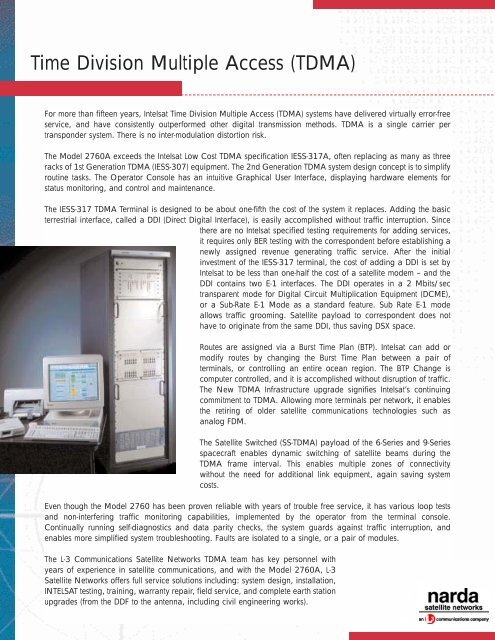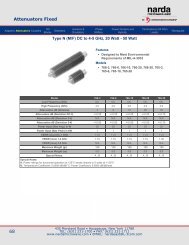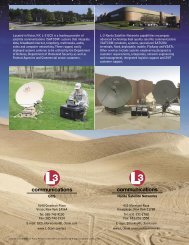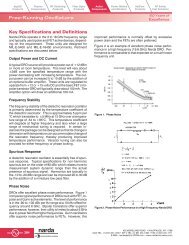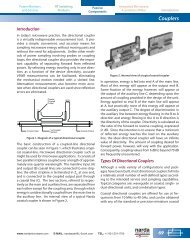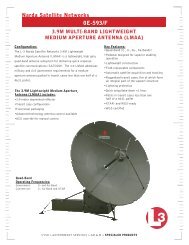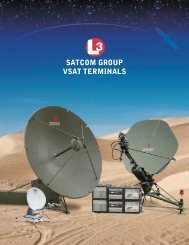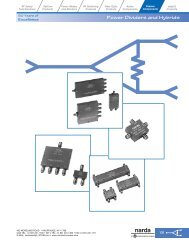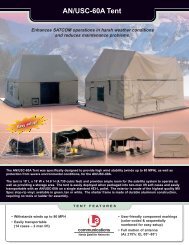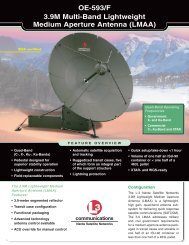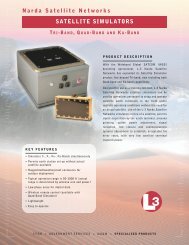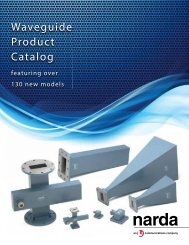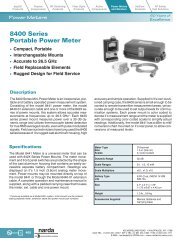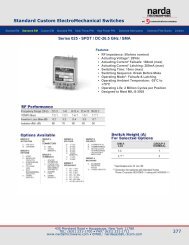TDMA-datasheet (8/01) - Narda
TDMA-datasheet (8/01) - Narda
TDMA-datasheet (8/01) - Narda
You also want an ePaper? Increase the reach of your titles
YUMPU automatically turns print PDFs into web optimized ePapers that Google loves.
Time Division Multiple Access (<strong>TDMA</strong>)For more than fifteen years, Intelsat Time Division Multiple Access (<strong>TDMA</strong>) systems have delivered virtually error-freeservice, and have consistently outperformed other digital transmission methods. <strong>TDMA</strong> is a single carrier pertransponder system. There is no inter-modulation distortion risk.The Model 2760A exceeds the Intelsat Low Cost <strong>TDMA</strong> specification IESS-317A, often replacing as many as threeracks of 1st Generation <strong>TDMA</strong> (IESS-307) equipment. The 2nd Generation <strong>TDMA</strong> system design concept is to simplifyroutine tasks. The Operator Console has an intuitive Graphical User Interface, displaying hardware elements forstatus monitoring, and control and maintenance.The IESS-317 <strong>TDMA</strong> Terminal is designed to be about one-fifth the cost of the system it replaces. Adding the basicterrestrial interface, called a DDI (Direct Digital Interface), is easily accomplished without traffic interruption. Sincethere are no Intelsat specified testing requirements for adding services,it requires only BER testing with the correspondent before establishing anewly assigned revenue generating traffic service. After the initialinvestment of the IESS-317 terminal, the cost of adding a DDI is set byIntelsat to be less than one-half the cost of a satellite modem – and theDDI contains two E-1 interfaces. The DDI operates in a 2 Mbits/sectransparent mode for Digital Circuit Multiplication Equipment (DCME),or a Sub-Rate E-1 Mode as a standard feature. Sub Rate E-1 modeallows traffic grooming. Satellite payload to correspondent does nothave to originate from the same DDI, thus saving DSX space.Routes are assigned via a Burst Time Plan (BTP). Intelsat can add ormodify routes by changing the Burst Time Plan between a pair ofterminals, or controlling an entire ocean region. The BTP Change iscomputer controlled, and it is accomplished without disruption of traffic.The New <strong>TDMA</strong> Infrastructure upgrade signifies Intelsat’s continuingcommitment to <strong>TDMA</strong>. Allowing more terminals per network, it enablesthe retiring of older satellite communications technologies such asanalog FDM.The Satellite Switched (SS-<strong>TDMA</strong>) payload of the 6-Series and 9-Seriesspacecraft enables dynamic switching of satellite beams during the<strong>TDMA</strong> frame interval. This enables multiple zones of connectivitywithout the need for additional link equipment, again saving systemcosts.Even though the Model 2760 has been proven reliable with years of trouble free service, it has various loop testsand non-interfering traffic monitoring capabilities, implemented by the operator from the terminal console.Continually running self-diagnostics and data parity checks, the system guards against traffic interruption, andenables more simplified system troubleshooting. Faults are isolated to a single, or a pair of modules.The L-3 Communications Satellite Networks <strong>TDMA</strong> team has key personnel withyears of experience in satellite communications, and with the Model 2760A, L-3Satellite Networks offers full service solutions including: system design, installation,INTELSAT testing, training, warranty repair, field service, and complete earth stationupgrades (from the DDF to the antenna, including civil engineering works).
Specifications<strong>TDMA</strong> Traffic Terminal IESS-317AFrame period of 2 mSecBurst Transmission bit rate of 120 Mbits/secNominal Clear Sky BER of 1 x 10 -10 with FEC BCH 7/8 applied topayloadOperates in any satellite beam coverage type(Assignments set by INTELSAT)QPSK modulation with coherent demodulation (CQPSK), phase locked tothe <strong>TDMA</strong> System clockPerformance monitoring of uplink and downlink data displayed with timeindexed BER graphs and G.826 chartsModem Integrated Transponder Hopping SwitchesIF Switches for multiple transponder operation incorporated into Modulatorand DemodulatorSupports four uplinks and four downlinks, in any combination of quantities(Assignments set by INTELSAT)Isolation >55 dBCo-channel isolation >55 dBSwitching time less than 250 nSecTerrestrial Interface Basic terrestrial interface: Direct Digital Interface (DDI) Physical and Electrical properties compliant with G.703 (75 ohms unb. -120 ohms bal.) Framed G.704 mode, regenerates outgoing frame per G.704, G.706 Unframed 2 Mbits/sec mode completely transparent regarding data –Supports all manufacturers’ DCME Terrestrial clocking: Recovered satellite timing, Recovered terrestrial timing,External G.821 stable clockTerminal PhysicalBurst Mode ModulatorIF output frequency 140 MHzIF output level approx. -3 dBmModulator carrier level on-offratio >50dBIF output impedance 75 ohmsBurst Mode Demodulator Coherent demodulation /recovers clock from receive data Input range +2dB to –10 dB(12 dB dynamic range) IF input frequency 140 MHz /80 MHz bandwidth Supports worst case carriertolerance of ±25 kHz fromnominal Supports burst to burst frequencyvariation for all series satellites Supports burst to burst amplitudevariation of 5 dB IF input level -5 dBm nominal IF input impedance 75 ohmsStandard rack enclosure 24/36/79 in (61/92/2<strong>01</strong> cm)EMI suppressive enclosure 24/40/81 in (61/102/206 cm)Weight approx. 450 to 700 lbs/205 to 320 kgs depending on enclosure,and level of expansionCard modules on plug-in Euro-standard 6U long form factorEIA 19 inch rack mount enclosureOptional CE Mark Qualified Model 2760AISO 90<strong>01</strong> Registered435 Moreland Road• Hauppauge, NY 11788Ph: +1-631/231.1700 • +1-800/524.8262Fx: +1-631/231.1558www.L-3com.com/satellitenetworksEm: SN.mktg@L-3com.com


